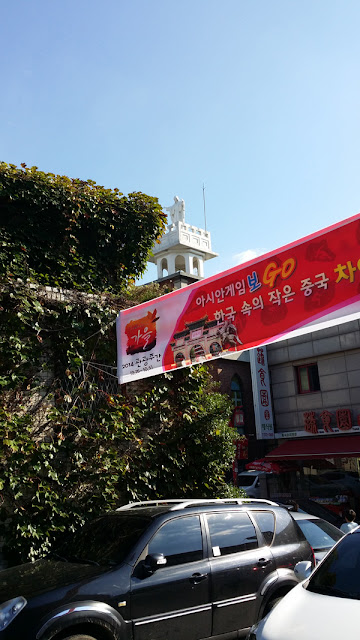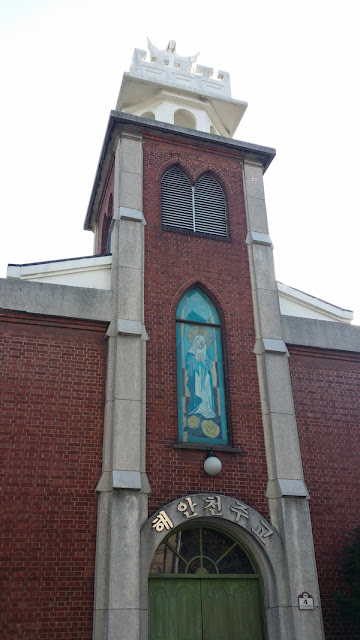Today's adventure involved a subway ride out to Incheon's Chinatown. I was on a quest for hwadeok mandu, the tandoor-baked dumpling done up in a manner vaguely resembling a Cornish pasty.
I saw, to my dismay, that Chinatown was crowded. This was probably because of the Asian Games currently being hosted in Incheon—that fact, combined with the fact that today is Gaecheon-jeol (Heaven-opening Day), or National Foundation Day, would explain the number of people filling the streets of this little district. There were lines everywhere—lines out the door of every restaurant, and a huge line for the hwadeok mandu. I wandered about town first, grabbing some tiny lamb skewers, a J-shaped ice-cream cone, and a Coke before finally joining the queue of fellow supplicants waiting for those much-vaunted dumplings. The big question was: would the food be worth the wait?
Below, click on the "landscape" images to see them full-size.
 |
| main gate of Incheon's Chinatown |
 |
| the crowded hwadeok-mandu stand |
 |
| the line |
 |
| Jesus watches over us from a distance |
 |
| Haean Catholic Church (haean means "coastal") |
 |
| the banner spanning the street is for the Asian Games |
 |
| one of many sets of steps |
 |
| Confucius statue |
 |
| on the side of the pedestal: the life of Confucius explained |
 |
| side street |
At this point, I wandered back to the line for the hwadeok mandu and saw that it hadn't shrunk any since my arrival in Chinatown. I shrugged and joined the line. The overall wait wasn't too painful: it was about twenty-five minutes. The mandu people were working like mad to serve us as fast as they could, and they were obviously the most popular business in the whole district.
 |
| standing on line |
 |
| the Chinese character bok/복/福, meaning "happiness" or "good fortune" |
 |
| someone |
 |
| inner workings of the mandu-making facility |
 |
| getting closer to ordering |
 |
| the sign says hwadeok-mandu has become an Incheon institution |
 |
| so close now |
 |
| just about at the head of the line |
 |
| here comes my order |
 |
| et voilà |
 |
| first peek |
 |
| there it sits |
 |
| first bite |
So how did these things taste? Were they worth the wait? Did the reality live up to the reputation? Short answer: I thought the hwadeok mandu were great, but I have to say that they were also very bland, and definitely needed some kind of spicy dipping sauce to liven them up. Next time I go back, I'm either bringing my own sauces or I'm going to ask the lady whether she has something for me to slather on the mandu.
The final photo, below, shows that these mandu truly were baked in a tandoor, as you can see from the charring and cracking. Of special note was the bread, which definitely has a Western consistency and mouth-feel. I almost felt that, if the meat filling had been switched out with something more pasty-like, the mandu would have been even better.

So! That was my Incheon adventure today. Chinatown isn't all that much to see, really: the restaurants almost all serve Korean-style Chinese food, which is hugely disappointing, given the supposed number of actual Chinese people living in that part of town. If I were more into history and architecture, however, I'd probably find Chinatown fascinating on that level: the city's buildings hint at a tangled cultural past, and the presence of so many churches, intermingled with the ubiquitous Confucian iconography, hints at an interestingly cosmopolitan spirituality. There's a bit of Mos Eisley in Incheon's Chinatown, but Chinatown is far too happy and touristy to be an echo of 1990s Itaewon. This is no wretched hive of scum and villainy; what it is is a district that's been thoroughly Disneyfied.
Of more interest to me than the architecture were the lamb skewers I had: at W1,000 each, they were cheap and tasty, but not very filling. I've got an idea, though: I might buy some Costco-style naan, fry it up with garlic and olive oil, make some tzatziki, bring along some lettuce and tomatoes and cucumbers and sriracha, then go to Chinatown, order about W6,000 worth of lamb skewers, and make some gyros with all my ingredients.
One last piece of trivia: I noticed that hwadeok mandu were also going by the name hangari mandu. A hangari is a large clay or stoneware pot, like the type used to hold enormous quantities of fermenting kimchi or gochujang. I'm not sure, but I assume that the hangari in this case is the tandoor oven, which is somewhat hangari-shaped.






























No comments:
Post a Comment
READ THIS BEFORE COMMENTING!
All comments are subject to approval before they are published, so they will not appear immediately. Comments should be civil, relevant, and substantive. Anonymous comments are not allowed and will be unceremoniously deleted. For more on my comments policy, please see this entry on my other blog.
AND A NEW RULE (per this post): comments critical of Trump's lying must include criticism of Biden's or Kamala's or some prominent leftie's lying on a one-for-one basis! Failure to be balanced means your comment will not be published.